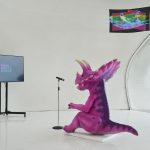UCCA Dune presents Monira Al Qadiri: Haunted Water. Monira Al Qadiri’s (b. 1983, Dakar) practice is a deep dive into petro-cultures and their possible futures, gender performance, and the aesthetics of sadness in the Middle East. Spanning video, sculpture, and installation, Haunted Water offers a comprehensive overview of the artist’s work in recent years, along with four new pieces commissioned by UCCA. Throughout, Al Qadiri investigates how the oil industry has transformed her home country of Kuwait and the broader Gulf Region, and as well as the impact these large-scale environmental and economic changes have had on social relations and local lives. The exhibition also touches upon traditions related to pearl diving, previously a major economic activity in the Gulf before oil. At UCCA Dune, this thematic focus subtly resonates with the seaside setting of Beidaihe, itself undergoing economic transformation. Approaching human and non-human subjects alike, Haunted Water intends to explore how we interact with history, personal or otherwise, through the vehicle of art. Monira Al Qadiri: Haunted Water marks the artist’s first institutional solo exhibition in China and is curated by UCCA Curator Luan Shixuan.
The exhibition’s artworks oscillate between two central motifs: oil and pearls. All over the world—not least of all in the Gulf Region—petro-capitalism has infiltrated ecologies, national politics, and everyday life. Petroleum can provide countries with wealth and the impetus for development, but may also lead to colonization, economic imperialism, inequality, and instability. Oil compresses time and space: it is biological energy, brought into existence by the sun eons ago, accumulated and transformed for millions of years before being used by humanity to accelerate history. Positioned as a non-human subject in Al Qadiri’s practice, oil has a number of similarities with the exhibition’s other motif, pearls. Both are culturally classified under the much-mythologized category of “resources,” and the unique optical refraction of oil surfaces is reminiscent of the iridescence of pearls. Furthermore, prior to the discovery and extraction of oil in the Gulf, pearl diving was the region’s main economic activity, representing the pre-modern antecedent to petro-modernity. Both oil and pearls blur distinctions between living and non-living entities, leading biological and historical temporalities to interact and overlap.
In the exhibition, themes including the oil industry, ocean ecologies, and mysticism parallel and draw upon one another. In the past, the Gulf’s pearl divers would sing songs as they worked on boats, a tradition that has for the most part disappeared. These songs return, however, in the first work the viewer encounters, titled Diver (2018). In the film, synchronized swimmers wearing iridescent suits dance rhythmically in dark, oil-like waters. Further pieces situate the viewer within an alien landscape of petroleum extraction: the levitating and rotating drill tips of Future Past 3 (2023) and OR – BIT (2016-2018); a dinosaur, representing the past life of oil, singing the story of petroleum in Seismic Songs (2023); and the transfigured, aestheticized oil pipelines of NAWA (2023). Reservoir (2019) appropriates an industrial imaging technique, printing geological renders of oil reservoirs on polyester in a subtle sendup of how oil produces the lifestyle items through which we express individual identity. Murex mollusks stuck to oil tankers are the protagonists of Gastromancer (2023), a sculptural installation with sound. These creatures’ strange, poetic discourse describes their experience of changing sex—oil tankers are covered in a protective coat of reddish paint that can leak into the seas, and exposure to this contaminant causes the mollusks’ biological transformation. This semi-fictional narrative describes the irrevocable changes wrought upon the ocean ecology by the oil industry, a theme further explored in the work SS Murex (2023).
This expanded, mystical imagining of ocean ecosystems continues in the works Divine Memory (2019), Man of War (2023), and Holy Quarter (2020). Divine Memory adopts the perspective of aquatic life to probe the buried memories and genetic codes left in the human body by our oceanic ancestors. Man of War uses the metaphor of jellyfish and their symbiotic relationships to explore potentials of interspecies coexistence in the post-petroleum era. Finally, in UCCA Dune’s inner gallery, the fictional extraterrestrial presence in Holy Quarter takes an interplanetary perspective to reflect on the mysterious, anomalous existence of oil. The film is narrated by black pearl meteors discovered in the Empty Quarter deserts of the Arabian Peninsula, which the artist blows up into sculptural forms.
In Haunted Water, the vanishing rituals of pearl diving and the uncanny origins of the oil industry haunt the Gulf Region. Both based on human exploitation of the natural world, albeit in different ways, these two economic activities offer Al Qadiri an opportunity to explore non-human subjectivities and intelligences. By juxtaposing these different voices along with cultural and geological history, the exhibition presents a compelling portrait not only of Kuwait and the Gulf, but also an entire world shaped by resource extraction and economic acceleration.
Press release from UCCA Dune



